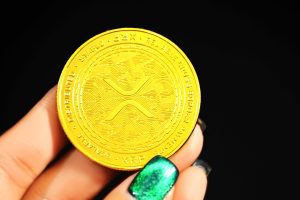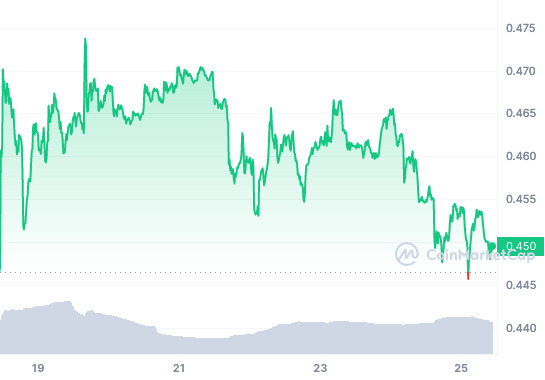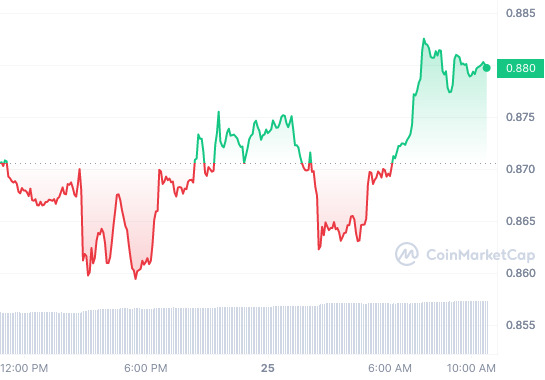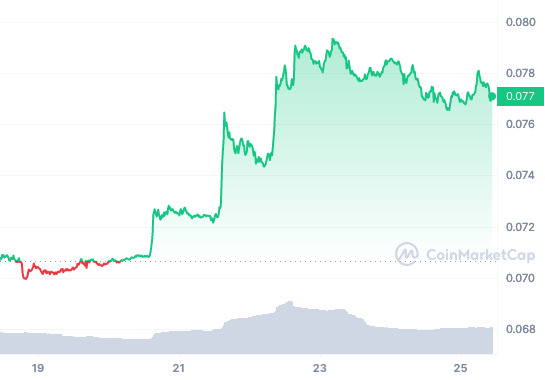Join Our Telegram channel to stay up to date on breaking news coverage
The last 24 hours have seen some of the most significant changes and advancements in the crypto market. The market hit a mark of $35 billion to make a 21.45% increase since our last next cryptocurrency to explode report when the market lost 3.36%.
Some factors responsible for this include the rise witnessed in the DeFi space as it hit $2.4 billion and held 6.85% of the overall crypto market volume in 24 hours. In the same way, all stablecoins now hold 93.17% of the entire crypto market in the last 24 hours as it is now worth $32.61 billion.
Some of the top gainers today have been at it for the last 24 hours and they are only consolidating their gains. It is evident that investors are closing in better on Render Token (RNDR) seeing it has sustained an 8.41% push in the last day. Trading at $2.73, its current sales volume has now hit $297,470,104, making retain the top spot.
We are, once again, out to examine the best crypto performers and probably uncover why investors might be massively interested in them. Although most crypto assets possess an outstanding potential to give high returns to investors at any time, there is always a need to make informed decisions before investing.
The Next Cryptocurrencies To Explode
If the crypto market will change the global financial landscape as predicted, the market must then be led by innovative investors. We offer some factors that contribute to their insights so that other investors and prospective ones can benefit from them too.
1. Robotera (TARO)
RobotEra (TARO), as it officially goes, is a metaverse and a sandbox imitation. In this spectacular metaverse, a player owns and also controls a robot which is considered as himself in the metaverse. The rule of the virtual world is that individual players will acquire resources such as land and everything else. They will also manage their resources as they deem fit and might be able to create robot companions.
A revolution truly began when the idea of the metaverse swept the blockchain space. Those projects that incorporated the metaverse did considerably well during the bear market and are advancing better as the bullish run is getting back.
Although the bear market isn’t completely gone, the metaverse maintains its position at the fore of most discussions in the blockchain and among crypto users. Although RobotEra is a relatively new project, it is well-positioned to create a positive impact when it launches new features in its metaverse.
RobotEra plans to have its project as a community based and centered one. As a result, users can explore different creations and also develop non-fungible tokens that are tradeable within the metaverse.
Players in RobotEra’s metaverse can interact and share with each other through the platform’s sharing features. It’s a feature that also connects players across different worlds as they develop various entities like museums and events like concerts.
It is built on the Ethereum blockchain and its increasing popularity makes it a recent choice of investment. TARO is the next big cryptocurrency to explode to take note of.
2. Launchpad XYZ (LPX)
As for Launchpad XYZ, it gained so much of its popularity because of the novel idea behind the project. It is one that set out to bring ease into the lives of crypto investors and traders generally. Its developers are working on a general suite that will contain various crypto dashboards. Users will be able to, in one place, have access to various opportunities available in the NFT and crypto markets alike.
The concepts of Web 3, cryptocurrencies, blockchains, DeFi, and NFTs are not very common to most regular people but LPX wants to make that a thing of the past. Certainly not through some cumbersome processes but with tools that reduce the entry barrier to the space.
Launchpad XYZ wants to make new insights and analytics available from every part of the Web 3 community. It will eventually be able to lead a lot more people into the new phase of internet usage.
At the core, Launchpad XYZ has become a melting pot where all crypto enthusiasts and users can get together and then get access to a wide range of tools, content, and features. The platform’s overall goal is to cut down on the bottlenecks that users go through while they use various Web 3 elements.
Its design comes with an intuitive interface that optimizes user experience and is easy for everyone to use. It is estimated that 10 million users will join the Web 3 space through LPX. It will be done through encouragement for users to boost their investment yield.
Launchpad XYZ does not target just individuals. Institutional investors can also use the platform. It will be useful for them to incorporate Web 3 elements into acquisition models for their users. The platform’s engagement system and reward method make sure that Web 3 is the standard acquisition tool for users rather than the traditional texts and emails that have become quite moribund.
Launchpad XYZ says its ecosystem will keep evolving and come up with new functions and features. This is in tandem with its goal of making sure everyone has access to Web 3 and all its functions.
3. Ripple (XRP)
XRP is positioned to be the next cryptocurrency to explode for several reasons. Ripple is a finance company that builds various products aimed at solving global financial settlement issues via its own remittance mechanism and exchange. Ripple was founded as Ripplepay by Ryan Fugger in 2004 before Bitcoin gained prominence. The company was later co-founded in 2012 by Jed McCaleb and Chris Larsen when they joined Fugger.
Ripple’s basic aim was like what Bitcoin set out to achieve. Which is to make payments more secure, faster, and easier globally. The major difference between Ripple and others like it is that it is not based on the blockchain but rather, it is a centralized system.
The XRP ledger development commenced in 2011 by Arthur Britto, David Schwartz, and McCaleb. It was started as an alternative to taking care of the lapses of Bitcoin. When the ledger was officially launched in 2012, it naturally assimilated the XRP token to aid its operations.
Note that Ripple changed its name a number of times between 2012 and 2015. It was first changed from Newcoin to OpenCoin in 2012. It became Ripple Labs in 2013. And eventually, in 2015, it became known as Ripple.
At the onset, Ripple said XRP was a straightforward peer-to-peer network. The company said its native token is a faster, energy-efficient, and cheaper asset for processing transactions in a few seconds. It consumes far less computational energy than a number of other cryptocurrencies.
It has been debated over the years if Ripple’s XRP is a smart investment choice. The debates became more intense because of the various controversies and lawsuits the company finds itself in. In spite of that, there are a lot of reasons why it has been an investor’s choice.
Some of these reasons are because XRP has been one of the most stable cryptocurrencies with regard to its market capitalization. It can also be a good store of value because it is efficient in executing transactions. On top of that, environmentalists appreciate it because it aids a greener environment. You can check out Ripple on eToro.
4. Polygon (MATIC)
Polygon has its native cryptocurrency called MATIC. It is used to pay staking fees on the Polygon network among other use cases. It is also the case that MATIC users have a right to participate in governance by voting on the Polygon network. This is effective when they vote for changes and features.
The platform was first launched in 2017 as Matic Network. Its developers, however, rebranded it to Polygon in 2021. The name MATIC was later bestowed on its native currency when it was launched.
As it is powered by its MATIC token, Polygon set out to develop blockchains and projects that are compatible with the Ethereum blockchain. The tokens are used to secure and govern the network, as well as, to pay transaction fees. Polygon deploys a modified form of the proof-of-stake mechanism to properly operate its platform.
By default, Polygon lets users do a lot of what they can do on the Ethereum mainnet. It, however, attracts fees that can be described as paltry. These can be seen on decentralized exchanges, lending and saving protocols, and NFT marketplaces like SushiSwap, QuikSwap, Aave, and OpenSea respectively.
In order to use the Polygon network, you would have to send some crypto assets into a crypto wallet. From there, you can bridge your cryptocurrency to the Polygon network, especially stablecoins. You might equally need to bridge some MATIC as well but the charges are considerably low.
The low transaction fees and almost instant transaction time make Polygon a perfect means of gaining actual experiences while using DeFi. However, don’t forget that the DeFi space can be volatile, so you should watch your investment. Polygon is listed on eToro.
5. Tron (TRX)
Tron is another platform for decentralized digital assets and it has its own cryptocurrency. The native cryptocurrency of the Tron network is Tronix or simply TRX. A Singaporean non-profit organization, the Tron Foundation, founded the platform in 2017 as it aimed to host an entertainment system that would ensure effective digital content sharing.
The asset was restricted and used in Asia in its early days but it has now become a globally used digital asset in international settlement. There were well over 50 million Tron users as of 2021.
The platform was founded by Justin Sun and it has offices in the country it was founded and also in San Francisco.
Tron employs peer-to-peer networks, as well as blockchain features to remove middlemen and let content creators sell their content straight to end users. The solidity program is used by software developers to create various apps that get hosted on the platform for use by the community.
With the TRX currency used on the network, users get to pay content creators directly to access their applications and other content. Content creators on Tron don’t pay any transaction fee to the network because TRX transactions are equally free on the platform.
An up point for Tron is that users can store their assets in a hardware, mobile, or desktop wallet.
6. Neo (NEO)
The NEO blockchain was developed to completely digitalize identities and assets via smart contracts for the purpose of achieving a global smart economy. The theory behind smart economies has it that, digital identities and assets are essential to improve everyone’s quality of life.
NEO has a goal of automating digital asset management via the process of smart contracts. This will end up with the goal of eventually building a network-based distributed smart economy framework that uses decentralized apps.
NEO was founded in 2014 by Erik Zhang and Da Hongfei as AntShares. It was only renamed NEO in 2017. As a blockchain-based platform, it has two native tokens on its network, NEO and NEO Gas. It also enables smart contract development and digital assets.
To find more tooling and documentation to #BUIDL on Neo N3 check out the developer portal
Come check out the most developer-friendly blockchain platform out there
Native oracles. Native distributed storage. 100% finality. Code in your preferred languagehttps://t.co/6bvP2okOdo
— Neo Community (@NeoN3_Community) May 25, 2023
Originally, NEO described its smart economy framework as a combination of digital identities, digital assets, and smart contracts. All these, it says, come together to form the smart economy.
The platform says digital assets are not limited to digital property but also include physical assets that got tokenized when their value is transferred to the blockchain and a token is issued for each of those assets. Thus, such tokenization creates a decentralized but traceable, trustworthy, and transparent means of asset management. It is also free of middlemen and related expenses.
Users will then be able to buy, sell, circulate, or exchange by any means different assets as they deem fit. NEO equally supports protecting assets when they are registered on its platform. This gives them valid digital security and identity.
NEO’s digital identity, on the other hand, enables the verification of important information about participants – either individuals or corporate entities that exist in the digital space. Securing every bit of individual and corporate information via the blockchain, encryption methods, and consensus mechanisms is important as lives become digital.
NEO makes use of the Public Key Infrastructure standard to manage identities. It does this when it creates encrypted keys used in verifying identities. Thus, it is possible to verify digital identities by using technologies like facial recognition, voice, fingerprints, and others.
NEO’s smart contracts, on their part, are codes that execute transactions automatically. They also ratify agreements between various parties in a contract. Smart contracts help to eliminate the need for third-party participation because transfers are completed automatically. Smart contracts equally make room for transparency, traceability, and transaction permanence. Visit eToro to check out NEO.
7. IOTA (MIOTA)
IOTA as a smart contract platform is designed to take care of payments and other settlement transactions that are carried out on physical devices that are connected to the internet. MIOTA is the native token used by the IOTA platform to facilitate these transactions.
As a break away from dominant cryptocurrencies like Bitcoin, IOTA is structured on a decentralized ledger technology that is quite different from what we have on the blockchain. The proprietary technology the IOTA uses is called “Tangle.” This is a consensus algorithm that demands that users have to validate two other IOTA transactions before they complete their own transactions.
In the real sense, Tangle can be called a direct acyclic graph consensus algorithm. This method does not require miners or third-party validators. It does not also require blocks or transaction fees. This mechanism lets the network beat the cost and scalability problems associated with regular blockchain.
The direct acyclic graph structure was designed to deal with the scalability problems and costs associated with blockchain. This was done by enabling lower computing costs, no-fee payments, and connectivity with IoT devices.
The IOTA structure appeals for use in the IoT ecosystem because it does away with the instability created by high transaction costs. This would normally need humans to monitor it and intervene—exactly what IoT was invented to eliminate.
The first advantage of IOTA is the absence of transaction fees. There is absolutely no need for gas fees as with Ethereum, or a reward system for miners as with Bitcoin. Since there are no miners and validators, IOTA is free to use for data transfers.
It also guarantees faster transactions. Regular blockchains usually see slow movements as a result of the time required to create new blocks. Bitcoin’s blockchain has the capacity to handle about five transactions every second. This, however, might vary from time to time. As for Ethereum, it is usually around 15 transactions per second. For IOTA, on the other hand, its network can handle as many as 1,000 transactions per second.
IOTA is also Energy efficient. By design, IOTA accommodates devices like sensors that work in a low-energy space. As a matter of fact, IoT devices that have little computing power, such as toasters, have the capacity to write any data into IOTA’s Tangle.
Adaptability to various use cases. Big corporations might adapt IOTA for their respective use cases. Once there is IOTA Access, an open-source system that gives access to control systems, an owner can remotely give someone else access to their car, for example. Finally, there is a decentralization roadmap as IOTA’s 2.0 version is completely decentralized. Do check out IOTA on eToro.
8. Stepn (GMT)
Stepn (GMT) is the first NFT game, powered by Solana. It revolutionizes the concept of “move to earn.” It is, in short, a Web3 lifestyle application that combines augmented reality with the tokenization of regular activities such as exercising. Stepn users can earn cryptocurrency tokens just by walking or running with their NFT sneakers. The NFT sneakers are basically a pair of virtual sneakers, they determine the duration of your training and how much you would earn.
Stepn’s aim is to motivate people across the world to exercise more by rewarding everyone with tokens when they carry out exercises. GMT is one coin to watch out for as it well may be the next cryptocurrency to explode.
Sneakers Just a Tap Away ?
Users will not need a crypto wallet to purchase #STEPN Sneaker NFTs. They can simply use Apple Pay to buy in a quick, private, and secure way.
How it works: Purchase SPARK credits with Apple Pay, 10 spark credits = 1 USDC.
[2/6]— STEPN | Public Beta Phase VI (@Stepnofficial) May 22, 2023
It is the first fitness application built on the Solana network. Players will not just earn tokens when they exercise but it has a gaming dimension to it too. Players are also able to drop treasure boxes while they are at their exercise sessions.
As the first application built on Web3, Stepn has made gotten a huge investment of close to $5 million from investors like DeFi Alliance, Solana Capital, and Morning Star Ventures. These are investors who share the platform’s vision. It was said that the funds it raised will go into building an application that will be an inspiration to millions to get them exercising and then improving their general well-being while they earn some passive income.
9. Mask Network (MASK)
Mask Network is a digital portal that lets users easily transfer either encrypted messages, cryptocurrencies, or DApps over social networks without a need to migrate. This, therefore, creates a decentralized DApplet ecosystem. In other words, the network has set out to bridge the new and open internet and put it right on the existing one.
Because people now live most of their lives on the Internet, and the current Internet is made of one big tech company after the other, people necessarily give up control of their priced privacy and autonomy. They cannot, as much, get a breathing space in between these platforms. A situation has now been created such that many people want to overthrow the big tech companies.
MASK, however, say they don’t want to overthrow the big tech companies but to create something else above them. The platform says cryptography and the Web 3 structure are helping them realize this.
The Mask Network has been operating for almost three years. In the first version of the platform in 2019, the simple operation it provided was sending and receiving encrypted messages on social media with some access control. This was done without the aid of a centralized server. The platform equally kept its user interface consistent with other platforms so it could cut down on-boarding costs.
Text, for example, is a form of information. If you can send a text via the dialogue box, the same logic will allow you to send other things such as pictures, code snippets, documents, applications, and all. The next version they released in 2020, the platform enabled payment too.
This focus and rate on feature onboarding make MASK one of the best investment choices this time.
Read more
Best Wallet - Diversify Your Crypto Portfolio
- Easy to Use, Feature-Driven Crypto Wallet
- Get Early Access to Upcoming Token ICOs
- Multi-Chain, Multi-Wallet, Non-Custodial
- Now On App Store, Google Play
- Stake To Earn Native Token $BEST
- 250,000+ Monthly Active Users
Join Our Telegram channel to stay up to date on breaking news coverage






